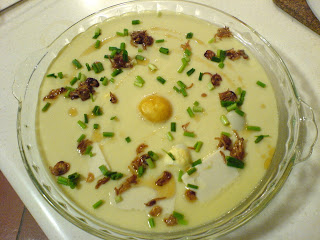In addition, you can add whatever ingredients to the egg mix you fancy - it only depends on what's available in your fridge, and what your tastebuds clamour for.
I've got two recipes here, but the basic steam egg preparation is as follows:
1. 1 egg to 100ml of water (or Chicken stock. The amount is 1 egg to 100ml of liquid.)
2. Pepper and Salt to taste
3. A bit of Chinese cooking wine for fragrance
4. Fried shallots, a teaspoon of sesame oil and spring onions for garnishing.
The method is to simply beat items 1-3 and pass the mixture through a sieve into a dish for steaming. The sieve will remove most of the bubbles so that you get a smooth texture for the egg. After that, you can then arrange the other ingredients you want into the dish.
Finally, the crucial step is in the steaming of the egg itself. Make sure that the dish is covered when steaming. This helps prevent water condensing onto the egg mix, and scarring it; ensuring a shine to the egg. Steam with a very low flame - which means that you should not hear the rapid boiling of water that you usually do when steaming other dishes. Steam until the egg is set, which can be between 15-20 minutes, depending on the amount you made and the size of your wok/steamer.
You can check whether the egg is set by using a knife and poking the centre of the dish. It's done when the egg doesn't run.
Steamed Eggs with Mushroom and Toufu

 Ingredients:
Ingredients:3 Eggs
200ml water
100ml Chicken stock (I use the liquid Knorr Chicken stock from the box.)
1 tsp Hua Tiao cooking wine
Pepper and salt to taste
2 dried Shitake mushroom, soaked to soften and sliced
1 box Silken Toufu
Method:
1. Assemble the egg mix as explained above.
2. Arrange the mushroom and toufu as desired.
3. Cover the dish and steam for about 15 to 20 minutes on a low fire, until the egg is set.
4. Garnish with fried shallot, sesame oil and chopped spring onions. You might want to garnish with sliced fresh chilli if you like it spicy.
Steamed Eggs with Quails' Eggs and Toufu


Ingredients:
3 Eggs
200ml water
100ml Chicken stock (I use the liquid Knorr Chicken stock from the box.)
1 tsp Hua Tiao cooking wine
Pepper and salt to taste
6 Quails' Eggs, hardboiled and shelled
1 box Silken Toufu
1 Salted egg yolk
Method:
1. Assemble the egg mix as explained above.
2. Arrange the toufu and quails' eggs as desired. You don't have to stop at 6 eggs - any number is fine. *winks* Put the salted egg yolk in the centre of the dish.
3. Cover the dish and steam for about 15 to 20 minutes on a low fire, until the egg is set.
4. Garnish with fried shallot, sesame oil and chopped spring onions. You might want to garnish with sliced fresh chilli if you like it spicy.
The list of ingredients to add to the egg is really up to the imagination. You might want to try:
- Crabsticks
- Button mushrooms
- Sliced fish (like threadfins)
- Sliced fish cakes (especially those cute Japanese patterned ones)
- Sliced meat (marinated with a little light soy sauce for between 10 to 30 minutes)
- Gingko nuts
- Wolfberries
- Broccoli
- Carrot strips





